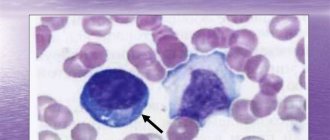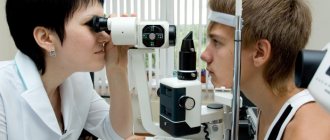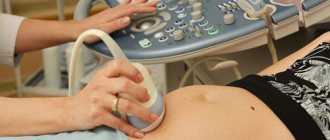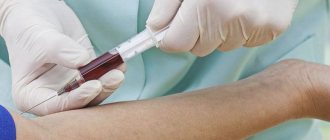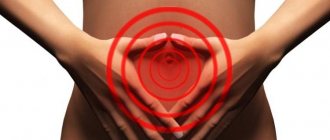Examination of the condition of the uterus and fallopian tubes is extremely important not only because it is a matter of the woman’s health, but also a matter of the health of the possible child. Hysterosalpingoscopy (this is the name of this procedure; otherwise - USGSS ) is one of the medical diagnostic procedures. Ultrasound of the fallopian tubes is a modern way of studying these organs for patency. The examination is carried out using ultrasound and contrast fluid.
What types of ultrasound are there?
Ultrasound examination of the uterus can be performed in 4 ways. Let's look at each of them in more detail.
Transvaginal ultrasound of the uterus and appendages
Transvaginal probe for ultrasound
An ultrasound probe is inserted into the vagina, with a condom previously put on it. The procedure is painless, but does cause some discomfort.
This type of examination is usually prescribed in cases where it is necessary to carefully and in detail examine the internal organs. Read more about transvaginal ultrasound.
Transabdominal ultrasound
During an abdominal ultrasound, organs are examined through the abdominal cavity (lower abdomen), without going inside.
Typically used for general examination rather than for detailed diagnostics. Read more about transabdominal ultrasound.
Intrauterine ultrasound
The procedure involves inserting a thin ultrasound probe into the uterine cavity. Such an examination is prescribed by a gynecologist only for certain diseases.
Causes of disorders in the reproductive system
The main reasons that can provoke genital dysfunction include:
- termination of ectopic pregnancy
- development of inflammatory processes in the appendages: salpingoophoritis, adnexitis, oophoritis
- progression of endometritis - an inflammatory process that affects the inner lining of the uterus and occurs as a complication of abortion, curettage
- formation of adhesions caused by surgical interventions, peritonitis
- abnormal development of internal genital organs (bicornuate uterus)
To confirm the diagnosis, a comprehensive examination by a gynecologist and a number of diagnostic procedures are required: both instrumental (ultrasound) and laboratory. In order to fully examine the uterus and its appendages, the administration of contract drugs is required. The procedure is carried out only in case of objective indications; this is not a routine study recommended for all categories of women.
Bicornuate, vestigial uterus
A bicornuate uterus is a pathology of organ development, which is accompanied by the formation of two separate parts with cavities. In the lower part of the uterus, such “horns” unite, and a common canal opens into the vaginal area. Such a disorder occurs as a result of hereditary predisposition and exposure to external provoking factors. These can be toxic substances, viral infections, heavy metals, pathogenic microorganisms of bacterial origin.
There are no specific symptoms for this disorder. In some cases, menstrual irregularities, uterine bleeding, miscarriage, and difficulty conceiving may occur. In most cases, a bicornuate uterus is discovered by chance, during a routine examination by a gynecologist. In most cases, specific therapy is not required. Surgical correction is performed only if there are difficulties with conception.
Oophoritis
Oophoritis is an inflammatory process that affects the ovaries. Develops under the influence of infectious and inflammatory processes: endometritis, vulvovaginitis, adnexitis, sexually transmitted infections. Among the predisposing factors that can provoke pathology are impaired functioning of the immune system, regular hypothermia, a history of multiple abortions, surgical interventions, the use of an intrauterine device, and disruption of the natural microflora.
The disease is accompanied by intense pain in the lower abdomen, radiating to the sacrum or lower back, and intense purulent or mucous discharge. The pain intensifies when urinating. There are also complaints about deterioration in general health, the presence of intermenstrual bleeding. Therapy begins with treatment of the cause that provoked the oophoritis. They use medications with anti-inflammatory, antibacterial effects, as well as general tonic and immunomodulatory agents. During treatment it is recommended to abstain from sexual intercourse.
Salpingo-oophoritis
Salpingo-oophoritis is a pathological process in which the fallopian tubes and ovaries become inflamed. One of the main reasons that leads to infertility. Develops under the influence of infectious pathogens: chlamydia, gonococci, mycoplasma, staphylococcus, Escherichia coli, streptococci. It is observed in women who are subject to regular hypothermia, overwork, stress, abortion, and multiple births.
The disease is accompanied by pain in the lower abdomen, which persists both during physical activity and at rest. Vaginal discharge with an unpleasant odor and green color is observed, and body temperature rises. A woman complains of nausea, general weakness, libido and menstrual cycle disorders. During therapy, antibiotics, anti-inflammatory drugs, and physiotherapy are used.
Adnexit
Adnexitis is an inflammatory process that affects the uterine appendages. Leads to simultaneous inflammation of the fallopian tubes and ovaries, provokes adhesions. The causative agent of the disease is pathogenic microorganisms (chlamydia, gonococcus, streptococcus, staphylococcus). The disease is accompanied by pain, discomfort during menstruation, increased body temperature, weakness, and increased fatigue. For purulent forms of the disease, surgical intervention is indicated. In other cases, therapy is carried out in a hospital setting with antibiotics and painkillers.
Adhesive disease
Adhesive disease is a pathological condition in which internal organs and tissues begin to grow together with the help of connective tissues. They occur as a result of damage and drying of internal organs, contact with foreign objects (gauze, medical gloves, etc.), under the influence of infectious pathogens and rupture of appendicitis or gall bladder. Most often, the course is asymptomatic; during therapy, preference is given to surgical intervention.
Endometritis
Endometritis is a pathology of the uterus of infectious origin, which is observed in women after the birth of a child. It develops under the influence of pathogenic microorganisms that inhabit the genitourinary system. Predisposing factors for the development of endometritis include cesarean section, the presence of wound surfaces after separation of the placenta, and dysfunction of the immune system. The disease is accompanied by increased body temperature, purulent discharge, chills, and deterioration in general health.
Ectopic pregnancy
An ectopic pregnancy is a pathological process in which the fetus begins to grow and develop outside the uterine cavity. Develops under the influence of endometriosis, hormonal and endocrine disorders, and a history of abortion. It can lead to the development of cavitary bleeding, which requires immediate surgical intervention.
How to prepare for an ultrasound of the uterus and appendages
Depending on the correct preparation for the ultrasound examination, its results will depend. To ensure the most accurate readings you need to:
- For transvaginal ultrasound, you must empty your bladder immediately before the procedure. In this case, the last meal should take place 8-12 hours before the procedure. And in a day you can rid your intestines of gases, for example, by taking Smecta.
- During an abdominal ultrasound, the bladder should be full at the time of examination. Therefore, an hour before the procedure, you need to drink a liter of still water or tea. The day before the examination, exclude foods that cause gas from your diet.
- With intrauterine ultrasound, the only requirement is an empty bladder; no other preparatory measures are required.
Another important point is on what day of the menstrual cycle to do an ultrasound of the uterus. Due to the fact that the size and structure of the genital organs constantly change throughout the entire cycle, correct data can be obtained on the 5th, 6th and 7th day from the start of menstruation.
Interpretation of ultrasound of the uterus. Pathologies on ultrasound
The results of the examination are issued on the day of the ultrasound. On the form, the doctor notes the following points:
- size, thickness, endometrium of the uterus - they must correspond to the day of the cycle;
- are there any deviations?
- features of the structure of the cervix;
- ovarian size;
- presence or absence of follicles.
In addition, the following diseases may be indicated here when detected:
- fibroids (benign tumor);
- endometriosis (enlargement of the lining of the uterus);
- polyps;
- developmental defects;
- polycystic ovary syndrome;
- malignant tumor.
Normal uterus and ovaries according to ultrasound data
A healthy uterus should be slightly tilted towards the rectum or bladder. The size of the organ depends on whether the woman was pregnant.
| Dimensions | For a nulliparous woman | For a woman who was pregnant but did not give birth | For a woman who has given birth |
| Length | 42 – 48 mm | 49 – 54 mm | 55 – 60 mm |
| Width | 43 – 50 mm | 44 – 55 mm | 49 – 60 mm |
| Anteroposterior | 34 mm | 37 mm | 38 – 42 mm |
The thickness of the endometrium will vary depending on the day of the cycle. So, on the seventh day it should be 1 - 2 mm, and after ovulation - 10 - 15 mm.
A healthy woman's ovaries are located on the sides of the uterus, the corners of which are not very far from them. Sizes of organs in normal condition:
- length: 25 – 40 mm;
- width – 15 – 25 mm.
Anatomical features of the organ
The uterus is an unpaired hollow muscular organ that is located near the bladder and rectum. The fallopian tubes are hollow, paired organs that are an important part of the female reproductive system. They are located in a horizontal plane and originate from the lateral surfaces of the uterine fundus. Their length is up to 11-13 cm. The tubes are located in the folds of the peritoneum and are narrow cylindrical channels, which are covered from the inside by ciliated epithelium, and from the outside by a connective tissue membrane.
According to static data, the length of the left pipe is slightly less than the right one. The fallopian tubes are such tiny structural elements of a woman's reproductive system that most modern ultrasound machines simply cannot visualize them. These organs are in a constant “floating” state, which also makes it difficult to examine them in detail using ultrasound. In most cases, if the pipes are not visible, this indicates the absence of pathological changes.
Atypical location of the ovum
Incorrect position of the fertilized egg detected on ultrasound may indicate the following anomalies:
- Cervical pregnancy. Occurs in cases of low attachment of the fruit egg. Requires immediate intervention as it may lead to removal of the uterus.
- Ectopic pregnancy. A false fertilized egg appears, consisting of secretion secreted by the fallopian tubes or blood. On ultrasound, such an egg differs in shape and wall thickness.
- Hollow fertilized egg. This is normal for 1–2 weeks of pregnancy, since the fetus is still too small. But if the anomaly persists after this period, a medical interruption occurs.
Visualization
Normally, the fallopian tubes are not visualized during an ultrasound examination. This means that they are not visible. They can be seen on an ultrasound if there is an accumulation of fluid in the lumen of the fallopian tubes. And this is a sign of an inflammatory process, that is, pathology.
In addition to inflammatory processes in the fallopian tubes, an adhesive process can also develop. In this case, if the lumen of the tube is completely closed, a sactosalpinx and hydrosalpinx are formed - a cavity filled with liquid. The nature of the fluid can be determined through further examination, and an ultrasound will determine the presence of an inflammatory process and its location (right and/or left tube).




